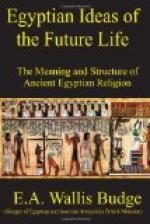Now as the gods who live in the Hall of Ma[=a]t with Osiris are two and forty in number, we should expect that two and forty sins or offences would be mentioned in the addresses which the deceased makes to them; but this is not the case, for the sins enumerated in the Introduction never reach this number. In the great illustrated papyri of the XVIIIth and XIXth dynasties we find, however, that notwithstanding the fact that a large number of sins, which the deceased declares he has not committed, are mentioned in the Introduction, the scribes and artists added a series of negative statements, forty-two in number, which they set out in a tabular form. This, clearly, is an attempt to make the sins mentioned equal in number to the gods of the Hall of Ma[=a]t, and it would seem as if they preferred to compose an entirely new form of this section of the one hundred and twenty-fifth chapter to making any attempt to add to or alter the older section. The artists, then, depicted a Hall of Ma[=a]t, the doors of which are wide open, and the cornice of which is formed of uraei and feathers, symbolic of Ma[=a]t. Over the middle of the cornice is a seated deity with hands extended, the right over the Eye of Horus, and the left over a pool. At the end of the Hall are seated the goddesses of Ma[=a]t, i.e., Isis and Nephthys, the deceased adoring Osiris who is seated on a throne, a balance with the heart of the deceased in one scale, and the feather, symbolic of Ma[=a]t, in the other, and Thoth painting a large feather. In this Hall sit the forty-two gods, and as the deceased passes by each, the deceased addresses him by his name and at the same time declares that he has not committed a certain sin. An examination of the different papyri shows that the scribes often made mistakes in writing this list of gods and list of sins, and, as the result, the deceased is made to recite before one god the confession which strictly belongs to another. Inasmuch, as the deceased always says after pronouncing the name of each god, “I have not done” such and such a sin, the whole group of addresses has been called the “Negative Confession.” The fundamental ideas of religion and morality which underlie this Confession are exceedingly old, and we may gather from it with tolerable clearness what the ancient Egyptian believed to constitute his duty towards God and towards his neighbour.
It is impossible to explain, the fact that forty-two gods only are addressed, and equally so to say why this number was adopted. Some have believed that the forty-two gods represented each a name of Egypt, and much support is given to this view by the fact that most of the lists of names make the number to be forty-two; but then, again, the lists do not agree. The classical authors differ also, for by some of these writers the names are said to be thirty-six in number, and by others forty-six are enumerated. These differences may, however, be easily explained, for the central administration may at any time have added




